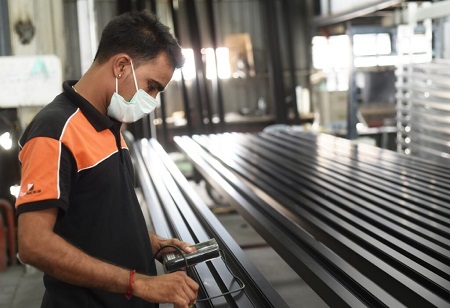Aluminium extrusion process has undergone tremendous technological advances, which have helped manufacturers in the production of lightweight & economical products such as cans, bottles & food packaging. In order to meet the needs of customers today & for years to come, aluminium is extruded through several different operations including punching, coining as well as drawing. The evolution of aluminium extrusion process has been in line with technological innovation.
The evolution of aluminium extrusion process started in the 1870s with the first heat treatment of aluminium. It soon became apparent that this was not a suitable material for structural purposes, but its flexibility and strength were found attractive for applications such as bottle tops, buttons and curtain rings. It was not until that
DuPont introduced an extruded product whose features were unique among other alloy castings: it possessed excellent formability and could be processed with almost any type of die head or cutter.
DuPont introduced the first aluminium extrusion in 1926. This product changed the course of material history forever, and remains a staple product for the industry today. Since 1825, the aluminium alloy extrusion process has evolved and continues today to be a cost-effective and economical way to produce high-quality end-products. Some of the applications of aluminium extrusion include:
Beverage cans & automotive parts
The
evolution of aluminium extrusion process refers to the changes that have taken place in the way an extrusion die is manufactured. The first two generations are based on equipment that were mass-manufactured: extruders and dies were large, and heavy machines. While it is an important manufacturing process that converts molten aluminium into a wide range of products, and includes beverage cans & automotive parts, it is one of the most modern & efficient way to
manufacture small-sized aluminium components.
The evolution of aluminium extrusion has been driven by advancements in aluminium alloy processing & mechanical engineering technology. Aluminium with a high thermal stability - above 1,550 degrees Celsius has found wide application in several industries such as aerospace industries, automobile industry and other product fields such as construction materials and household goods such as tableware.
It is a process in which a cast-iron mandrel is used to produce a long chain of aluminium bars. The process begins with the fabrication of the die, which is then inserted into the machine and machined to shape it into a three-dimensional shape. Next, molten aluminium is introduced through a series of holes machined into the die and allowed to flow down into the space created by the moulding shaft's grooves.
Modern architecture & engineering
Aluminium extrusions are a key part of modern architecture and engineering. They have an aesthetic appeal that is unmatched by any other material. Aluminium extrusion is used extensively in the construction industry, which makes it one of the largest end markets. In the past, aluminium was often extruded by teams of workers, who would cut aluminium bars and then weld them together. Today, large machines called extruders do the cutting and handling of materials and creating many products at once. These machines have replaced hand-operated processes that were previously used for producing aluminium pieces.
Aluminium extrusion is a continuous process which takes place in a die and moves metal from the die to the mold. Aluminium ingots are moved into the die cavity, where they are melted by furnaces, extruded through tubes and cooled by air circulators. The cooling liquid, usually water or steam, is blown through the extruded pipe at room temperature or reduced pressure so that backflow causes no loss of liquid to cool conventional dies. This forms an aluminium ingot which has been cooled and stretched into a wide range of wire shapes.
Extruded aluminium serves a purpose in the commercial and residential market, that is to increase the aesthetic quality of a structure where necessary, or leave a clean and commercial finish on a building structure. Aluminium Extrusion Process is a method of producing a structure from a moulded or cast metal. Aluminium Wire Fabricated Cage is used to obtain direct drive extruder, the extruder is made up of aluminium shafts, gears, cables and other components which are attached to the die with screws at the bottom and top of it. The extruder with their long axis of rotation can be applied to reduce the pressure in a hot-extrusion process.
In a nutshell
Aluminium Extrusion is one of the most common methods used in production of aluminium products. The older versions of extrusion processes used very slow cooling rates and low melting points, resulting in brittle materials with excessive heat recovery losses and resulting poor economics. In comparison to its predecessor, modern aluminium extrusion processes are faster and cheaper than ever before.
